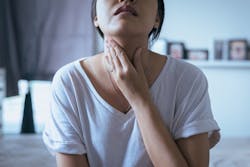Who has time to look for oral cancer? The basics of a screening most hygienists never do
Your patient arrives and you have a frenetic 45 to 60 minutes to accomplish a multitude of tasks. If anything gets dropped during a patient’s visit, it is usually the steps deemed least important or too time-consuming. So how do some hygienists handle this situation when time feels crunched? They take shortcuts, hurry the process, or ignore the simple steps to critical pieces of an appointment. Taking care of these forgotten or overlooked unchecked boxes could be not only a potential source of value in the patient’s eyes, but could also set you apart from the majority of dentists and hygienists who don’t take this step.
The average 3-, 4-, or 6-month dental hygiene appointment rarely includes this life-changing protocol that dentists and hygienists can simply perform on every patient, every day. Fewer than 15% to 25% of those who visit a dentist regularly report having had an oral cancer screening at all.1 Many clinicians say they do it, but why, according to the Oral Cancer Foundation, are 53,000 people going to be diagnosed this year alone with a condition that is typically discovered at a late stage, and sadly, usually found by the patients themselves, not a dental professional?2 It’s because dentists and hygienists often breeze through an oral cancer screening, not looking at specific landmarks, not palpating muscles, glands, and nodes, and not discussing potential symptoms with their patients to the extent that could be salvific.
For some patients, it's the most important part of your job
To the patient with unknown and undiagnosed oral cancer, this is the most important part of your job during their appointment! If suspicious lesions or lymph nodes are not detected because a dental professional did not perform an oral cancer screening, that patient remains at a much greater risk for metastatic changes. When you do not take the time to examine key landmarks, the patient in your chair could die within five years of diagnosis once it finally is diagnosed in advanced stages.3 The oral surgeon’s chair is not where we want our patients to lie because of our negligence.
You might also be interested in: Oral cancer screening: Resources for dental professionals
As a fellow hygienist, I have 30 years of experience seeing patients day in and day out, and I can appreciate the pressure to stay on time, to work toward a production goal, and to talk about things we like to discuss with patients. Since there never seems to be enough time, it is very easy to see how this vital step in our exam can get brushed off as nonessential or minimally important. Also, as hygienists, we feel like we aren’t hygienists if we don’t talk to our patients about flossing and brushing better. This puts the value of looking for oral cancer below the perceived need to talk about home care for the umpteenth time.
As a dental hygiene coach, it is rare that any of the clinicians I have mentored, both dentists and hygienists, perform a thorough head and neck, oral cancer screening. While many state that they do include this in their examinations, what I have observed is grossly lacking in thoroughness. However, if dental professionals knew exactly how valuable this portion of the assessment was, patients could be assured that they are receiving the very best care. If hygienists possessed the confidence to perform the extraoral and intraoral exams and knew enough about oral lesions, perhaps they could sleep better at night, knowing they went above and beyond. If it’s true that only 15%-25% of patients report having an oral cancer screening, that can also be understood in the inverse that 75%-85% of clinicians do not perform oral cancer examinations during a routine hygiene visit.1
I’m blessed to say that none of my patients have ever been diagnosed with head and neck cancer after a biopsy because of a referral from an oral cancer screening done in my chair, even though I have discovered many lesions during exams, and I certainly have sent many patients to oral surgeons for biopsies. In my 30 years of practicing, I have learned an efficient method to accomplish a meticulous oral cancer screening. I would love to share this with you. It is sure to boost your credibility from a patient’s perspective. This can become your routine in every hygiene visit to perform a five to seven minute, life-saving, oral cancer screening.
For the dentist and hygienist who are willing to get out of the usual routine and desire to wow their patients, please consider how to incorporate a complimentary oral cancer screening in your next hygiene appointment. The best way to move forward is by following these three easy steps:
- Go to YouTube and type in OCF Oral Cancer Screening or follow it here. It’s just one of many videos that can demonstrate the most comprehensive screening.
- Check Six-Step Screening and the Oral Cancer Foundation and read, read, read. Educate yourself on some statistics. Here's one from the Oral Cancer Foundation: “Oropharyngeal cancer will cause over 9,750 deaths, killing roughly 1 person per hour, 24 hours per day this year alone.”4
- Practice on a coworker a few times so you feel comfortable with your process.
I've created two checklists as a reminder of what to do when getting started. One is for the extraoral and one for the intraoral exam. Please ask permission from patients to touch them as you explain that you will be doing an oral cancer screening. When following a system, it is more important to have a rhythm and method that works for you versus feeling like you must follow exactly what others do. However, it is nonnegotiable that all these areas must be carefully screened.
Extraoral cancer screening
- Assess head, neck, face, and skin for changes in color, swelling, and symmetry.
- Palpate occipital nodes with head positioned forward.
- Palpate submental and submandibular nodes, pressing firmly against bony structure to detect enlargement in nodes.
- Palpate sublingual and submandibular glands and nodes. Have patient raise tongue to roof of mouth while palpating.
- Palpate mandibular jawline on facial surface.
- Ask patient to clench teeth while palpating parotid glands.
- Palpate muscles: masseter, buccinator, temporalis.
- Touch right and left TMJ areas; have patient open and close to observe for deviation, crepitus, or pain.
- Palpate preauricular and postauricular nodes using circular compressions.
- Have patient turn head to one side and lower chin while palpating sternocleidomastoid muscle and anterior/posterior cervical chain of lymph nodes. Palpate supraclavicular nodes. Repeat on the other side.
- Palpate larynx, thyroid, and trachea, having patient swallow while palpating.
Intraoral cancer screening
- Observe and palpate maxillary and mandibular labial tissues, including commissures.
- Visually observe maxillary and mandibular gingival tissues, including frenums.
- Retract buccal mucosa and examine, then palpate.
- Palpate submandibular and submental glands with one hand intraorally and one hand extraorally placed.
- Palpate alveolar ridges on mandible and maxilla.
- Palpate hard palate.
- Using 2x2 gauze, grasp tip of tongue and gently pull out of mouth, looking at dorsal surface and lateral borders of the tongue.
- Palpate and gently pinch sides of tongue between fingers, feeling tongue muscle.
- Remove 2x2 gauze, look at and palpate tip of tongue.
- Have patient lift tongue to roof of mouth to observe ventral side of tongue.
- Palpate floor of mouth from under chin while touching internally on floor of mouth.
- Using mouth mirror, look at all soft tissues for anything abnormal: hard/soft palate, gingiva, and buccal/labial mucosa, including retromolar pads and maxillary tuberosities.
- Using mouth mirror, have patient say long “Ahhh”; look at uvula, palatal glossal arch, and tonsils.
- Use Q-tips to gently stimulate parotid and sublingual glands for salivary flow.
With proper time management in your hygiene appointment and a commitment from the dentist and hygienist, an oral cancer screening can be done at every hygiene visit. Your patients will come to appreciate your skills and knowledge and, more importantly, you may save a life. Start today by knowing how to execute a quick screening. If you are a hygienist who is not currently doing this screening, don't wait for the doctor to tell you to include this as part of your protocol, and do not wait for your own comfort and mastery of this skill before you begin.
Patients will notice you are doing something different and will appreciate the great value you add to their appointment. This is one way to successfully offer patients the very best care. To help you avoid that awkward and devastating moment when a patient was diagnosed with oral cancer and asks why you never looked, make a commitment today to be that dentist and hygienist who makes this a priority. Since most oral cancer is detected by patients themselves at a late stage, the risk of not looking can cost a life. Don’t delay.
Now, when a patient walks in for their 45- to 60-minute hygiene appointment, you can go from being apathetic about the urgency and necessity of a thorough oral cancer screening to being confident in the value and importance of giving patients a service that many will come to appreciate your skill and the time taken to evaluate them for abnormalities. According to the Oral Cancer Foundation, “Oral cancer is our industry’s cancer.”
Editor's note: Originally posted in 2019 and updated regularly
References
- The role of dental and medical professionals. The Oral Cancer Foundation. https://oralcancerfoundation.org/dental/role-dental-medical-professionals/.
- Oral Cancer Facts. Oral Cancer Foundation website. https://oralcancerfoundation.org/facts/.
- Survival rates for oral cavity and oropharyngeal cancer. American Cancer Society website.https://www.cancer.org/cancer/oral-cavity-and-oropharyngeal-cancer/detection-diagnosis-staging/survival-rates.html
- Understanding oral cancer. The Oral Cancer Foundation. https://oralcancerfoundation.org/understanding/
About the Author

Tricia Markise Wonderly, RDH
Tricia Markise Wonderly, RDH, is a licensed dental hygienist. She has worked in general, periodontal, prosthodontic, and pediatric offices for over 30 years in Illinois, Washington DC, and Ohio. Currently she is coaching with Dental Hygiene Excellence and teaching other hygienists the pearls of the profession as her encore career to clinical hygiene, focusing exclusively on oral-systemic care. When not coaching, Tricia can be found kayaking and wilderness camping in Canada. She currently lives in Springboro, Ohio, and may be reached at [email protected].
